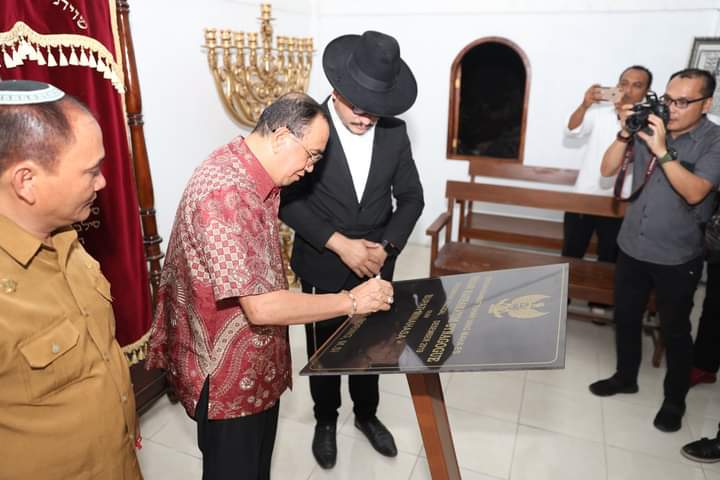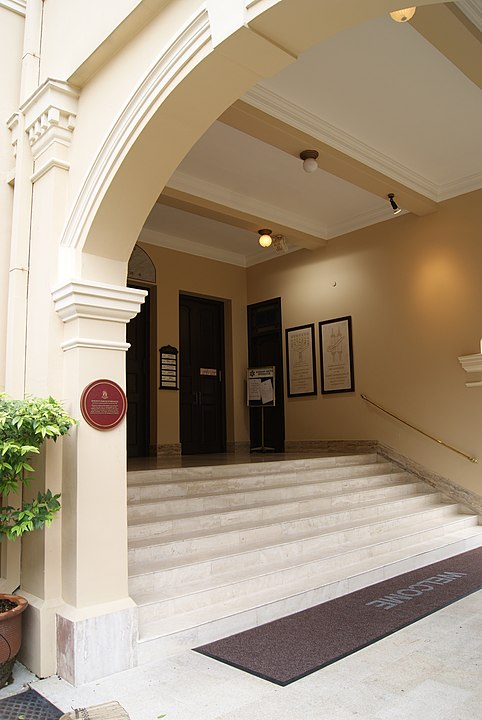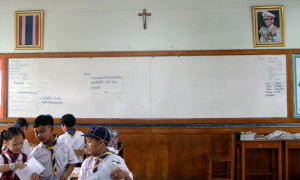The arrest in 2021 of a young Singaporean for planning attacks outside a synagogue raises the question of why a conflict in the Middle East would lead a Muslim in Southeast Asia to want to attack Jews. It is a story of contested beginnings, imperial power, and global conflict.
Some may think that antisemitism is just a Western hatred with no resonance in Asia, including Singapore. However, the case of a 20-year-old national serviceman detained by the Internal Security Department (ISD) after planning attacks on a synagogue there in 2021 shows otherwise. Moreover, there is well-documented antisemitism in both Malaysia and Indonesia.
Southeast Asian antisemitism has, however, often bemused scholars and researchers, because it has been described as an antisemitism without Jews. Historically, Jewish communities have been at best marginal, or often non-existent, within what is now the Muslim-dominated archipelago around modern day Indonesia, Malaysia, Singapore, and Brunei.
While centuries-old communities exist in India and China, records indicate Jews arriving in Southeast Asia in the wake of European colonisation from the seventeenth century. Most were traders, and communities across Southeast Asia probably never exceeded a few tens of thousands. The last community that existed in Penang, Malaysia, died out in the mid-twentieth century. In Indonesia, the only synagogue for many years was in Surabaya, but it became inactive due to tensions and declining numbers in 2009 and was demolished in 2013. Only two synagogues currently exist, one in Jakarta, serving a small community, while in 2022 the region’s first Holocaust museum was opened in Sulawesi, which is significant as Holocaust denial is often tied into modern antisemitism.

Sha’ar Hashayamim Synagoge inauguration by local government, in Minahasa in 2019. Image by Yaakov Baruch on Wikimedia Commons.
Singapore has the oldest active synagogue in the region, and many Jewish figures, such as David Marshall, were influential in the city’s history. Only a small local community still exists, but in the wider expatriate community there exists a good number of Jews as part of the nation’s sizable temporary workforce. Brunei has never had a synagogue.
It is useful to define some terms and context for antisemitism, because Southeast Asian antisemitism only exists within a wider global and colonial context. Antisemitism is a form of prejudice which affects Jews and those perceived as Jews, and has been around for over two thousand years. Any distinctive community that exists as a minority is likely to be the subject of prejudice, and Jews have been no exception. In the Jewish case, the intertwined history with Christianity has made it a widely prevalent and genocidal hatred.
What we now think of as the Christian religion began as a branch of Judaism; Jesus, his disciples, and Paul were all Jews and thought as Jews; Paul’s letters are effectively midrash, or traditional rabbinic commentary. The advocates of the early Jesus movement represented a new interpretation of Judaism that became focused on conversion outside the Jewish community. However, over a few centuries, Christians came to find their Jewish roots obscure, and when Emperor Constantine adopted Christianity as an official part of the state apparatus a seismic rupture essentially severed connections.
Moreover, over these centuries and in those that followed, Christians developed a whole literature and ideological frame that saw “the Jew” as abominable and even demonic. Virulent antisemitic tracts emanated from Christian bishops and teachers, reading antisemitic messages into the New Testament texts. Today, all mainstream Christian churches have acknowledged their complicity in the prejudicial hatred and environment that made the Shoah (Holocaust) possible.
We need to talk! Art, offence and politics in Documenta 15
Human-rights oriented Indonesian art collectives have been accused of anti-Semitism at one of Europe's largest art exhibitions, Documenta, in Kassel, Germany.
To understand the connection to Southeast Asia, however, requires understanding how European colonialism spread antisemitism, particularly around Egypt and elsewhere in the Middle East and North Africa (MENA). This led first to Arab Christians adopting antisemitic ideas, which seeped into secular Arab nationalism then into Islamic Arab nationalisms, and into a full-blown Islamic antisemitism. This latter move came during the 1930s, and two key figures were the mufti of Jerusalem Hajji Amin Al-Husseini and Syed Qutb of the Muslim Brotherhood. Qutb wrote a tract called Our Struggle With the Jews in in 1950 which still circulates in Southeast Asia today and defined an eternal enmity between Jews and Muslims, but drew on Western antisemitic tropes.
Alongside this, the importance of the current Palestine-Israel conflicts cannot be underestimated for how Muslims globally view Jews. Hence, in Southeast Asia, as elsewhere, the narratives on this shape discourses, with many Muslims perceiving what is often termed the “settler colonialism” and “apartheid” of Israeli state policy, and a certain form of Zionism, as driving a wedge between the communities.
Before proceeding, several caveats need noting. Firstly, accusations of Israel as a “settler colonial” state and engaged in “apartheid” are hotly contested, so I am only noting here a perception of this without arguing either way. Secondly, Zionism names a range of attitudes of Jewish people towards a homeland that may or may not be Israel (some early Zionists suggested South America may make a good homeland). As such, the excesses of militant Zionist settlers is far from definitive of all Zionisms. Thirdly, opposition to Israeli policies vis-à-vis Muslims is not itself antisemitic, nor does it entail hatred of Jews, and many local Muslims recognise this, especially in relation to their tradition, a matter we can unpack further.
In the Quran, hadith, and Islamic tradition, Jews—like Christians—were regarded as People of the Book (ahl al-kitab) and Protected People (ahl al-dhimma), and had resultantly lived peaceably in Muslim-dominated lands. Indeed, when persecuted or exiled by Christian rulers, many Jews had found congenial homes amongst Muslims who often welcomed them warmly. The Jewish golden age of philosophy, literature, and learning of the medieval period happened in Muslim-dominated Spain, as well as in such cities as Cairo, and Baghdad. Antisemitism can therefore be seen as something alien to the Islamic tradition, despite its adoption today by many Muslims under Western influence.
When we address Islamic antisemitism in Southeast Asia today, we therefore need to return to our earlier discussion about the growth of this tradition in MENA. As noted, many Muslims learnt antisemitism via Christian and secular Arabs, from Western colonial, secular, and Christian sources. But, in figures such as Syed Qutb of the Muslim Brotherhood, it became internalised as what we may term an Islamic religious ideological stance. Qutb’s role in the Muslim Brotherhood meant that antisemitism became embedded in Egypt and beyond, most notably in Saudi Arabia. It was really from this source, through what has been termed the Arabisation of Southeast Asian Islam, that antisemitism spread as a part of the Wahhabi-Salafism as taught from the 1980s onwards.
This is not, though, to deny colonial and other sources of antisemitism, and in Indonesia antisemitism was institutional in the colonial period, came with Nazi influence under Japanese occupation, and was spread by notable Christian nationalists such as Ratu Langie.
The global spread of modern Saudi Arabian and MENA Islam, including in the Southeast Asian region, means that antisemitism exists in many Muslim communities. The Israel-Palestine conflict has led many Muslims to see their fellows repressed by Jews, and news reporting has reinforced an antisemitic narrative that is essentially alien to traditional Islamic tenets.
The prominence of antisemitism in recent times, particularly in Malaysia, where we have noted the endogenous Jewish community has disappeared, may seem puzzling. But attention to the discursive function of the trope of “the Jew” and how antisemitism operates makes it clear.
Firstly, it was arguably under Prime Minister Mohamad Mahathir that antisemitism gained a major public profile there, a discourse he has repeated in recent years. He was instrumental in turning towards a Muslim identity in the political sphere and away from a secular framing. As such, given Wahhabi-Salafi infiltration and the prominence of Palestine-Israel as a point of identity for a global Muslim ummah (community), it was a natural discursive trope to help found arguments for a beleaguered and oppressed Muslim identity that would bind group identity and garner support.
Secondly, within Malaysia’s context, as Mary Ainslee has argued, antisemitism without Jews has been a cipher for a different group: the Chinese. In other words, antisemitic discourse about Jews as a minority but yet a prosperous and controlling group (playing on old antisemitic tropes noted below), has acted as a code to criticise and stir up resentment against local Chinese, perceived as a successful business community which prospers at the expense of Malays. A similar pattern has also been observed in Indonesia.
It has been noted that copies of Henry Ford’s deeply antisemitic text The Universal Jew were handed out at Mahathir’s political rallies in the 2000s. This points to the ongoing Western influence. Moreover, the conception of controlling and prosperous Jews plays upon tropes developed through European history, but very particularly on a nineteenth century forgery, The Protocols of the Elders of Zion, which allegedly records a secret meeting of Jewish leaders discussing their plot for world domination. Originally a scene from a novel, it has taken on a life of its own and has the passage we have discussed: from Europe (both France and Russia were posited origins), to MENA where it influenced Qutb’s writings, and now to Southeast Asia in the Islamic ideological framing of antisemitism.

The porte-cochère of Maghain Aboth Synagogue, Singapore. Image by Smuconlaw on Wikimedia Commons.
All this brings us back to the context of the detained 20-year-old Singaporean youth. While actual violence, or planned violence against Jews is rare in Southeast Asia—though a planned (Jemaah Islamiyah) JI attack in 2001 on Singapore targeted not just the US but also the Israeli embassy—antisemitic sentiment clearly festers regionally.
This is particularly tied to anti-Israeli sentiment. Amongst the countries surveyed here, only Singapore has close ties with Israel, and Malaysia in particular has had sometimes tense relations. But anti-Israeli sentiment can be separated from antisemitism (many Israeli and non-Israeli Jews criticise the government’s harsh policies towards the Palestinians). Therefore, while many Muslims regionally may criticise Israel, certainly not all are antisemitic. Muslims and Jews sit side-by-side in the Interreligious Organisation of Singapore and other platforms. In Indonesia, for example, some have stressed kinship. Respect for Jews, as People of the Book, is integral to Muslim identity for many.
As such, it was no surprise that Singapore’s Mufti and others expressed their outrage at the planned crime. Indeed, Jewish and Muslim leaders united together to condemn it. It may be said that it was not Islam that gave this young man these ideas, but a politicised hatred learnt via colonial imposition and the Israeli-Palestinian conflict.
Nevertheless, like synagogues globally, those across Southeast Asia have security in place, and the need for reviewing security across places of worship in Singapore has been noted. Although Singapore’s Chief Rabbi has contrasted the safety felt here compared to Europe, there is no room for complacency given regional discourses on antisemitism. Indeed, Singapore is something of an outlier amongst the countries surveyed in that peaceful rather than hostile discourse marks the Jewish-Muslim encounter. This is perhaps related to Singapore’s carefully curated interreligious landscape.
The response from, and amicable relationship between, Singapore’s Muslim and Jewish leaders and wider community is a sign of hope, but it is not the norm and is something that needs more regional support. It may be useful to stress the traditional amity of Muslims and Jews in the teachings of community leaders, in madrassahs, and the Malay language literature. Yet, it cannot be ignored that, in the region, antisemitism remains rife amongst many Muslims.
 Facebook
Facebook  Twitter
Twitter  Soundcloud
Soundcloud  Youtube
Youtube  Rss
Rss 



